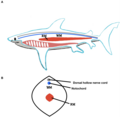Welcome to the shark portal

Sharks are a group of elasmobranch fish characterized by a cartilaginous skeleton, five to seven gill slits on the sides of the head, and pectoral fins that are not fused to the head. Modern sharks are classified within the clade Selachimorpha (or Selachii) and are the sister group to the Batoidea (rays and kin). Some sources extend the term "shark" as an informal category including extinct members of Chondrichthyes (cartilaginous fish) with a shark-like morphology, such as hybodonts. Shark-like chondrichthyans such as Cladoselache and Doliodus first appeared in the Devonian Period (419–359 million years), though some fossilized chondrichthyan-like scales are as old as the Late Ordovician (458–444 million years ago). The earliest confirmed modern sharks (selachimorphs) are known from the Early Jurassic around 200 million years ago, with the oldest known member being Agaleus, though records of true sharks may extend back as far as the Permian.
Sharks range in size from the small dwarf lanternshark (Etmopterus perryi), a deep sea species that is only 17 centimetres (6.7 in) in length, to the whale shark (Rhincodon typus), the largest fish in the world, which reaches approximately 12 metres (40 ft) in length. They are found in all seas and are common to depths up to 2,000 metres (6,600 ft). They generally do not live in freshwater, although there are a few known exceptions, such as the bull shark and the river sharks, which can be found in both seawater and freshwater, and the Ganges shark, which lives only in freshwater. Sharks have a covering of dermal denticles that protects their skin from damage and parasites in addition to improving their fluid dynamics. They have numerous sets of replaceable teeth.
Several species are apex predators, which are organisms that are at the top of their food chain. Select examples include the bull shark, tiger shark, great white shark, mako sharks, thresher sharks, and hammerhead sharks. (Full article...)
Selected article -
Like other members of its family, the angelshark is a nocturnal ambush predator that buries itself in sediment and waits for passing prey, mostly benthic bony fishes but also skates and invertebrates. An ovoviviparous species, females bear litters of 7–25 pups every other year. The angelshark normally poses little danger to humans, though if provoked it is quick to bite. Used for food since at least Ancient Greece, this shark is often sold on European markets under the name "monkfish". Since the mid-20th century, high levels of commercial fishing across the angelshark's range have decimated its population via bycatch – it is now locally extinct or nearly so across most of its northern range, and the prospects of the remaining fragmented subpopulations are made more precarious by its low reproductive rate. As a result, the International Union for Conservation of Nature (IUCN) has assessed this species as Critically Endangered.
Did you know (auto-generated)

- ... that the ampullae of Lorenzini enable sharks to sense electric fields?
- ... that a shark cost a competitor a silver medal in the spearfishing event at the 2014 Micronesian Games?
- ... that "the Hurricane Shark is real"?
- ... that Timo Meier became the first player in San Jose Sharks franchise history to score five goals in one game when he was 25?
- ... that Hixxy and Sharkey created a schism in the UK rave music scene in 1995?
- ... that Alexis Sharkey's last Instagram post before her murder documented her travels to Tulum, Mexico?
Categories
Related portals
WikiProjects
Selected picture -

More Did you know? -
- ... that the taillight shark has a gland on its belly that releases clouds of luminescent blue fluid?
- ...that the Jersey Shore shark attacks of 1916 killed four people and inspired Peter Benchley's novel Jaws (1974)?
- ... that the presence of the rare bigeye sand tiger in the Pacific Ocean was first suspected based on teeth recovered from the ocean floor?
- ... that the rough skin of the nursehound was once used as an abrasive called "rubskin", which cost a hundred times more than sandpaper?
- ... that the epaulette shark can survive for an hour without oxygen?
General images
Topics
For additional lists of marine life-related featured articles and good articles see:
Wikimedia
The following Wikimedia Foundation sister projects provide more on this subject:
-
 Commons
Commons
Free media repository -
 Wikibooks
Wikibooks
Free textbooks and manuals -
 Wikidata
Wikidata
Free knowledge base -
 Wikinews
Wikinews
Free-content news -
 Wikiquote
Wikiquote
Collection of quotations -
 Wikisource
Wikisource
Free-content library -
 Wikispecies
Wikispecies
Directory of species -
 Wikiversity
Wikiversity
Free learning tools -
 Wiktionary
Wiktionary
Dictionary and thesaurus














































